3 Yoga Asana + Pranayama techniques to manage anxiety and improve your resilience to stress
Yoga and Photo by Cecille, Vanessa on an Onyx White mat
Headache, racing heart, fatigue, shaky legs, poor sleep.. these are just some of the symptoms of chronic stress and anxiety, which in the long term can take a big toll on our mental and physical health.
Luckily, Yoga Asana and Pranayama offer you plenty of precious practical tools to shift the state of your nervous system and induce a relaxation response when you experience overwhelming feelings.
Working from the body to the mind, the following bottom up techniques from Yoga Therapy for Anxiety can help you improve your resilience to stress in the short and long term.
1. Gentle stretches, especially in the neck and shoulders
As Peter Levine, Founder of Somatic Experiencing, reminds us:
“If our muscles are tense, we unconsciously interpret this tension as foretelling the existence of danger, even when none exists. Tight muscles in the neck and shoulders may, for example, signal to the brain that you are likely to be hit. (…) Conversely, experiencing relaxed (and well-toned) muscles and belly can signal safety even when a person’s daily affairs are in turmoil”.
One of the ways your Asana practice can help you alleviate anxiety is by releasing muscular tension, especially in the areas that tend to contract when you are scared, angry or in general feeling under threat. For many of us, these are especially the neck and the shoulders, so you may want to incorporate targeted gentle stretches for the upper body, forward-folds that invite your head to drop, or reclined postures where you can safely release your chest and create space for your lungs to expand and soften.
Some examples include Eagle or Gomukasana pose arms (crossing your arms in front of you to stretch your upper back or binding behind you to stretch your pectoral muscles and triceps), interlocking your fingers behind your back to open your chest, soft forward folds like Dangle pose (releasing the weight of your spine towards the ground) and Caterpillar in Yin Yoga or gentle versions of chest openers, like Supported fish pose on a small bolster.
2. Grounding
From the point of view of the Chakra system, anxiety is often associated with an imbalance in the lowest chakras, especially Muladhara, which is related to our sense of safety, stability and connection to the earth.
When we lack grounding, we miss solid foundations and we tend to be overwhelmed and shifted off balance by the smallest trigger.
One of the key strategies to cultivate a sense of psychological grounding is to direct our awareness to the point of connection between our body and the floor, and to practice postures or movements that work with our lower body.
For instance, seated postures targeting the base of our spine (Paschimottanasana, Malasana, Baddha Konasana) or standing poses activating our legs and feet (Warriors or Chair pose) can anchor our mind to our roots and provide refuge from rumination and overthinking.
3. Breathing at the bottom of the lungs
The way we breathe has a profound impact on our physiology and as a consequence our states of mind.
Hyper vigilant states are associated with shallow, chest-focused and rapid breathing patterns, while calmer ones usually present long, slow and deep breaths that involve the full use of our diaphragm (the dome-shaped muscle attached at the base of our lowest ribs). Dirga Pranayama (3 parts breath) is a highly effective technique coming from Ancient India, which can help you slow down both your inhalation and exhalation and truly take the time to let your lungs expand and soften completely, immediately slowing down your heart rate and reducing the levels of stress hormones in your body.
Yoga and Photo by Cecille, Vanessa on an Onyx White mat
Want to discover more techniques to move out of stress?
Start your FREE trial of Transformative Movement Method, embodying Yoga for Mental Health, Pilates and Dance principles, or get in touch with Vanessa for a free consultation for a 1:1 Private Yoga therapy for Anxiety programme.
Please note that this article is in no way intended to replace medical advice or treatment for mental health issues. You are advised to talk to someone and seek help should you be experiencing mental health issues.
References
Levine, P. (2010). In an unspoken voice. North Atlantic Books.
Mason, H. & Birch, K. (eds) (2018). Yoga for Mental Health. Handspring Publishing Limited.
Vanessa Michielon is a Yoga and Dance Lecturer, and founder of the Transformative Movement method, empowering people of all walks of life to embrace Yoga, Pilates and Dance in order to improve physical health and achieve a balanced state of mind.
She is trained in Advanced Yoga Psychology, Yoga Therapy for Anxiety and Applied Polyvagal Theory in Yoga Therapeutics; Community Dance, Pilates and Barre. Vanessa believes that embodied movement can truly transform our life and wishes to help others find joy and purpose in their practice.
You can find her on Instagram and join her practices online or in pop up events in London. She is seen using her Onyx White mat.
Read next >>>


